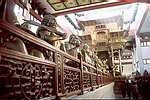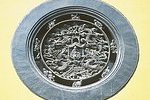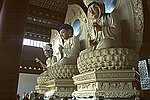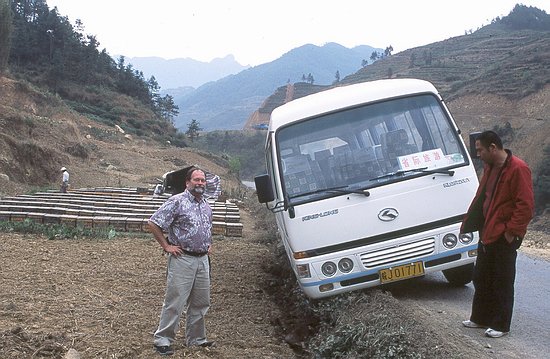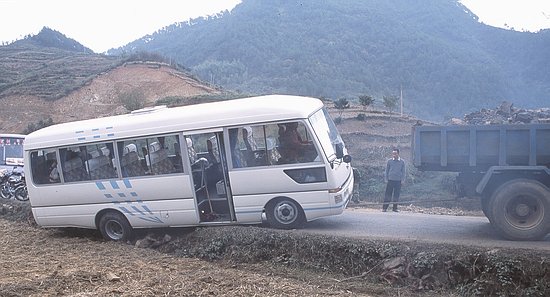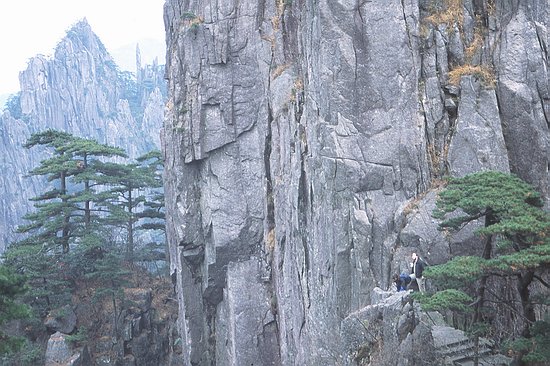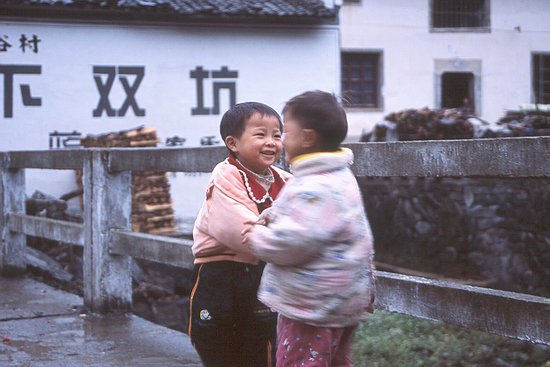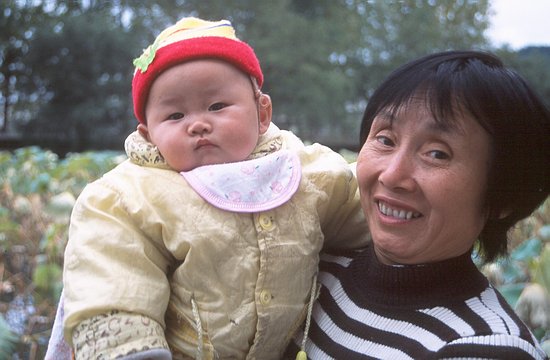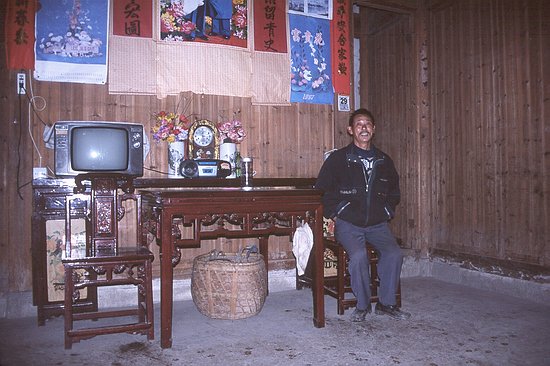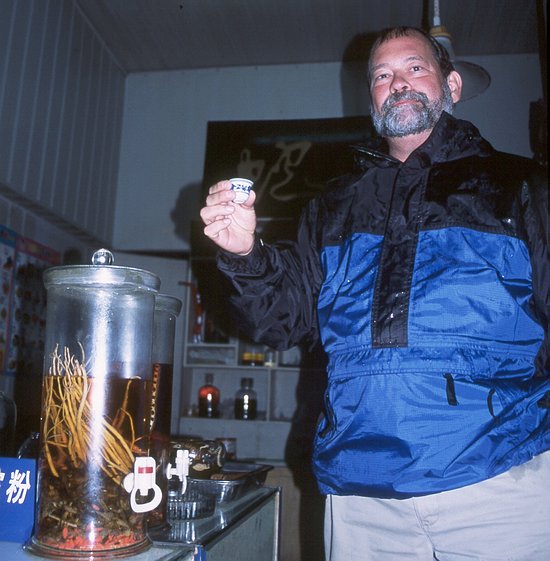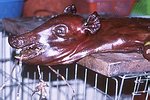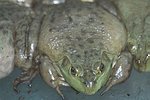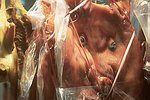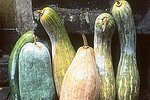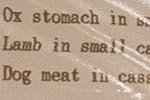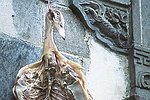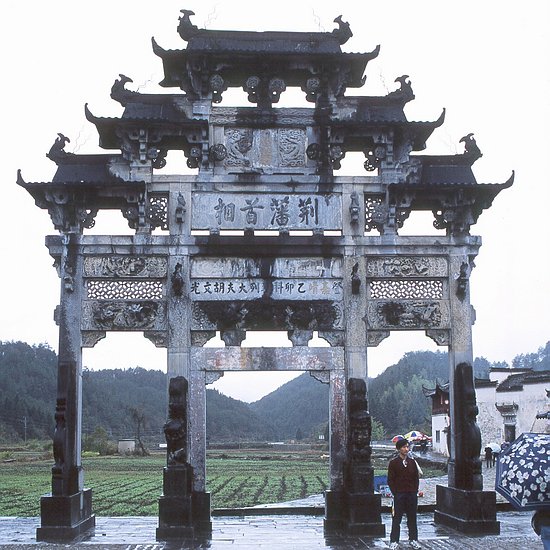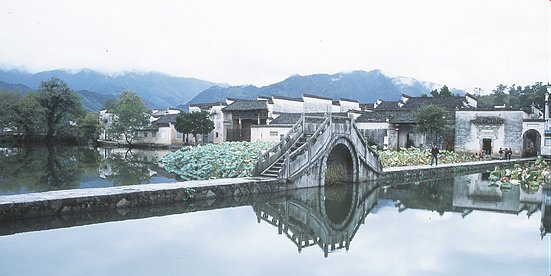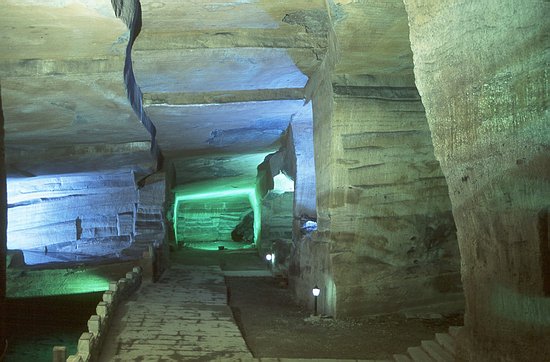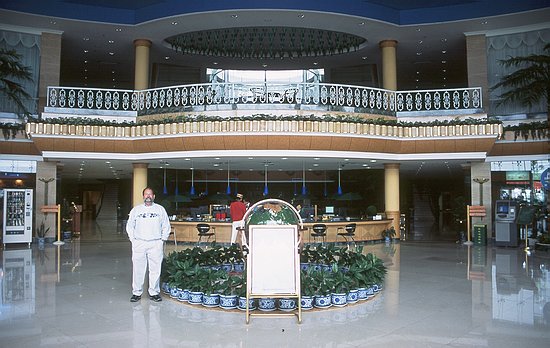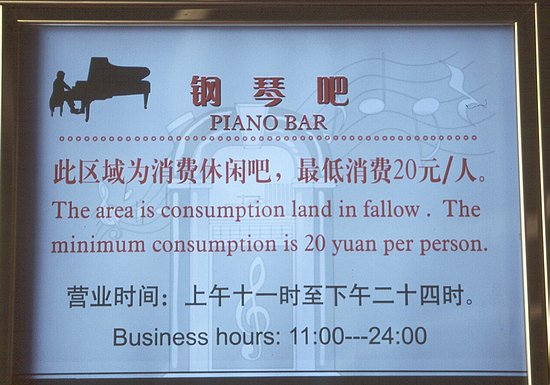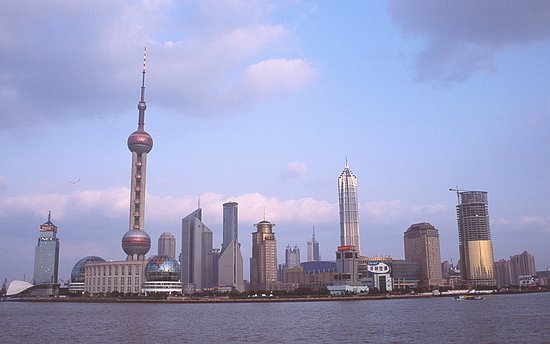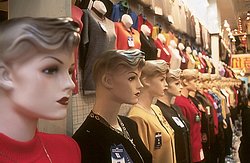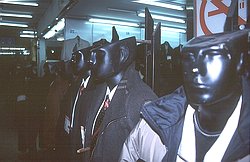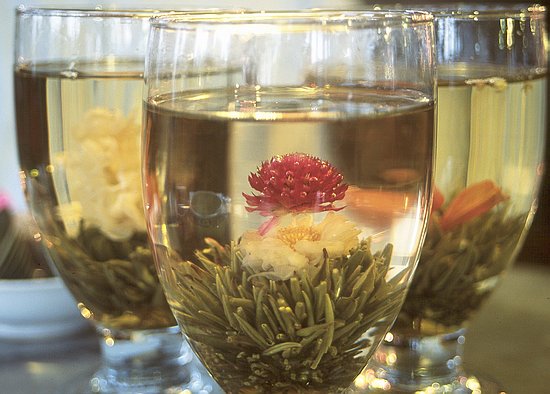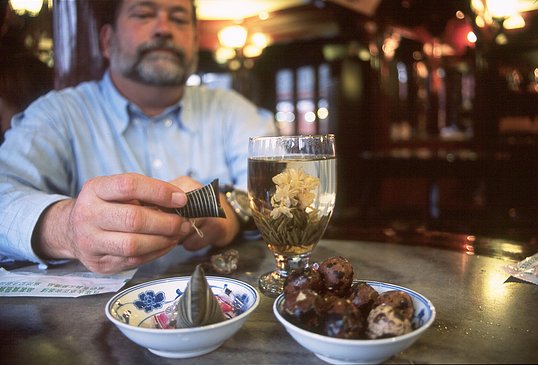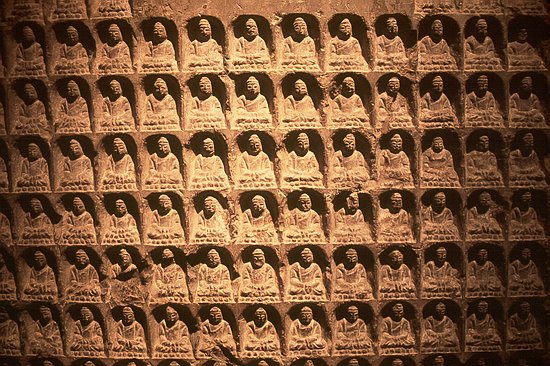
 Home
Home
 Updater
Updater
 Me
Me
 Living
Living
 Sport
Sport
 Work
Work
 Contact
Contact
 Germar's Monthly Updater
Germar's Monthly Updater
|
October / November 2002: China
End of October 2002, I gave a talk at a SPIE Remote Sensing conference, which was organized in Hangzhou, China. Hangzhou lies about 200 km South West of Shanghai, and has several historic landmarks. It's also a favored place for Chinese honeymooners (at least so I've read) because of its scenic beauty. In the middle of the city, surrounded by hills, lies the "West Lake". During a conference break, some colleagues and I rented a few rowboats with oarsmen, and explored the lake with its many ancient bridges, pavilions, and causeways. The lighting on the shot below is typical for China. The air is often hazy, and vivid colors are rare. All objects appear to be embedded in a calm ether.

Hangzhou's most important sight is the Lingyin temple, also known as Yunlin Buddhist Temple. It was founded in AD 326. During its peak time between AD 907 and 960, the complex included nine storied buildings, 18 houses, 72 halls, 1300 bedrooms for monks, and a faculty of more than 3000 monks. Everything is superbly restored, including the Great Hall with its 65 foot (19.6 meter) camphor-wood Buddha statue. For me, the most impressive building was the Hall of 500 Arhats, which covers a floor space of more than 3000 square meters. (In Buddhism, "Arhat" is the title given to those who have achieved nirvana. All Buddhas are arhats, but becoming a Buddha takes much longer than becoming an Arhat). Each Arhat statue is 1.7 meters tall, cast with bronze, and weighs about one ton. Even Mao was impressed when he visited the temple, and he gave order to save it from demolition during his cultural revolution (at least so I've heard). Below are just a view impressions from the vast complex.
Another of Huangshan's sights is the Tomb and Temple of Yue Fei. He was a general during the Song Dynasty. Despite is success in war, he was murdered by the emperor and his prime minister. To soften public indignation, the emperor's successor restored Fei's honor and ordered a proper burial. Up to this day, Yue Fei is an outstanding national hero. People are proud to get a picture of themselves taken with Fei's temple in the background, wearing their finest suit (I can't help of thinking of Japanese tourists in front of the Matterhorn whenever I look at the scene).
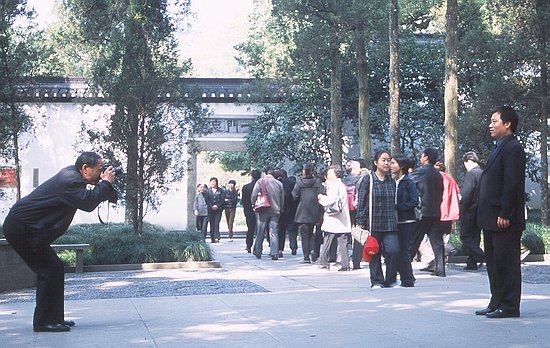
The shot below shows a typical apartment building of Hangzhou. I really liked the way the facade is decorated. There were neat shelves made of aluminum for flowers and laundry. Saving energy by drying clothes outdoors is a smart idea. My own tenancy agreement is certainly not progressive enough to allow this sort of energy preservation. I hope we can learn from China.
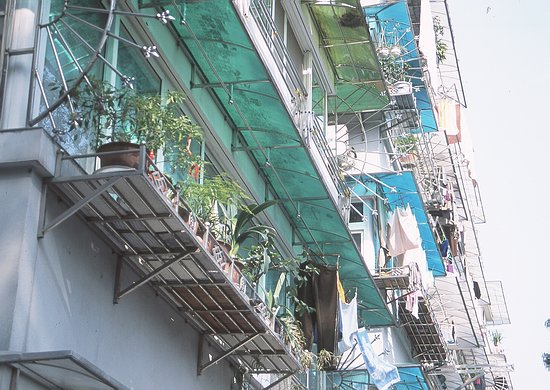
After the conference, I went with 9 colleagues on a bus tour through Chinese backcountry. We had planned to visit the Yellow Mountains and two ancient villages. The start of the tour turned out to be quite exciting. Our chauffeur was driving as if he were alone on the street. This strategy worked for about two hours until the road became narrow. When we were heading toward an oncoming bus, our driver didn't slow down but rather tried to stay as far right as possible. Well, he managed to avoid the other bus, but unfortunately the shoulder of the street gave way. It was a miracle that we didn't overturn. If we had, we would have crashed into a bee farm.
Below is a picture of the scene. To the right is our daredevil-driver and in the background is the bee farm.
There was fortunately some road construction going on nearby, and our tour guide was able to organize a tow truck in minutes. The picture below shows the first attempt to get us on the road again. While the truck was pulling, the rear of the bus slid off the road. The force of the towrope became so strong that the tow hook of the bus snapped. To make a long story short, our Chinese fellows finally managed to get the bus back on the pavement, and we could continue our journey.
It took about half an hour until our driver had forgotten the accident. One hour later, he was passing a car shortly before a bridge. I will never forget the view of the bridge's pillar flying toward us. I still don't understand how he managed to get around it. In fact, sitting in the bus and watching all kinds of obstacles almost hitting us was so nerve-wracking that our group decided to fly rather than drive back to Shanghai. It was a good decision, and I can highly recommend the fine service of China Eastern Airlines.
Below are some more impressions from our journey through rural China (click on pictures):
We finally arrived at the foot of the Yellow Mountains, which is also known as Mount Huangshan. It is part of the Anhui province and features lofty peaks, steep valleys, are bonsai-shaped pine trees. We took a cable car up the mountain and hiked for about one hour and stayed over night in a hotel on top of the mountain.
Below are a couple more impressions of the scenery. I believe that the mountains had a great influence on Chinese art. At least many scrolls that I have seen were decorated with landscapes resembling the pine covered summits of Mount Huangshan.
On our way back from the mountain, we stopped at an old village and were welcomed by the habitants and their children.
For some reasons, Chinese parents seem to believe that babies have to be wrapped in at least 5 layers of garment. I was sometimes wondering how many kids die from overheating. The Chinese government promotes a one-child per family policy, and infants are therefore often treated like little kings. The guy below even wears the color that was once reserved for the Chinese emperor.
I was invited to visit the inside of a house. The furnishing is quite typical. A table is put against the house's center wall with two chairs placed left and right from it, facing the dining room. Like in the picture below, the table is decorated with two vases, and a clock. On the left side is often a mirror, but our host decided to replace it with a TV set. I am wondering how he watches TV sitting with the back to it.
No visit to China is complete without trying the local food and beverages. Below, my colleague is sampling "snake wine". The recipe for snake wine seems to be rather simple: just kill one or more snakes, put them in a jar, and add plenty of hard liquor. To make it a bit more colorful, you may also consider adding some drained snake blood. I've also read that turtle bile booze is quite a delicacy, but I haven't tried it. I am not sure what's in the jar in the foreground of the picture. It's not the snake wine, but it certainly looks interesting.
Below are a few more ingredients of a fine Chinese menu. I don't want to be mistaken. We have eaten in excellent restaurants and most of the meals were delicious (including the frogs). I was not always sure what I was eating but that's what travelling to foreign countries is all about.
The next highlight of our trip was a visit to two ancient Chinese villages in the Southern Anhui province, Xidi and Hongcun. Both are on UNESCO's world heritage list as cultural and natural sites. Xidi was established in 1047. In former times, people had the custom of leaving their home town to earn money with a strong sense of bringing back honor to their families. When they became rich, they returned home to build archways, residences, and temples. Below is the archway of Xidi.
Hongcun has a similar architecture as Xidi and the shape of a ox. In the middle of the village is a pool in the shape of the crescent moon, which is regarded as the stomach of the ox. A canal zigzags through the village and is the intestine of the ox. Moreover, there are four bridges (the legs of the ox), a hill (the head), and ancient trees on top of the hill (the horns).
In the evening, we visited the Huashan Mysterious Grottoes. They are man-made structures, but nobody knows for what purpose. Some experts have calculated that they are at least 1700 years old, and were chiseled before the Jun Dynasty. Some people believe that the caves were used as troop or food shelters, others believe they are stone quarries or tombs for Emperors. No theory really makes sense. My theory is that it's a big hoax made up by the Chinese tourist department to lure visitors. The supposedly ancient chisel marks look exactly like the ones on concrete pillars that were recently built to prevent the grottoes from collapsing. Moreover, there are no traces of ancient human settlement such as stains from fires or torches. Look at the picture below and form your own opinion. Does this really look like a 1700 year old cave?
While visiting the ancient villages, we stayed two nights in the Huangshan Golf Hotel. The luxurious hotel was completely out of place, considering its location. My room was one of the largest I ever had in a hotel. It was even tastefully decorated and there was really a golf course when I looked out of the window. But there were also some odd things: for example, a label near the window told me that I was not allowed to open the curtains during night because of "photokinetic insects". Getting a drink at the bar was not possible. The only alcoholic beverage available was beer. A bit strange for a 5-star hotel.
The sign at the entrance of the bar was the most mysterious. Does the first sentence warn of latent tuberculosis? This would make sense since every forth Chinese citizen is infected with this disease.
Being back in Shanghai after our excursion back in time to ancient villages was a bit of a shock. Shanghai has a population of more than 13 millions and is still growing with a frightening pace. The economy is growing by 10-12% per year and streets, houses and high-rises are built everywhere. Whole districts are leveled, the former habitants relocated, and new factories and office buildings constructed. The gap between rich and poor is steadily increasing despite the fact that China is still ruled by the communist party.
Below is a shot from the Bund, the city's one-mile long fulcrum, toward Pudong Park with its "Oriental Pearl" TV tower. With a height of 468 meters, it is the world's third tallest TV tower after the 553-meter CN Tower in Toronto and the 535-meter Moscow TV Tower. To me, the skyline looked completely surreal and out of proportion.
Despite all the progress, there as still some remnants of communism. 90% of all female mannequins that I have seen in shops are of the type shown in the left photo below. Isn't it strange that a western looking model is the benchmark? The male counterpart doesn't have a brain, which, I think, is appropriate.
After strolling along the Bund, we visited the Huxinting teahouse in Shanghai's old town, and ordered tea. Or better, we chose from a menu of 100 different kinds of tea. The waiter brought us glasses with little green balls inside, and poured boiling water over them. The balls of tea leaves slowly opened, and beautiful flowers appeared, which were attached by little threads to the center of the tea balls. It looked beautiful, and tasted even better.
The tea was accompanied by quail eggs with crushed shell, which were boiled in tea, and sticky rice snacks artfully wrapped in leaves. The taste was interesting but I didn't think that it went well with tea.
On our last day in China, we visited the Shanghai Museum. It is a world-class museum. There are many pieces of art on exhibit that are more than 3000 years old. The culture that must have existed in China when people in Northern Europe and America were still living in caves is just amazing. The photo below shows a small portion of a 2-meter high piece of art; the size of a figure is about one inch.
Stamps are a very import part of Chinese culture and were used to prove the authenticity of documents. Stamp marks can be found on almost every old scroll, and also on newer ones made for tourists. Stamps are made from a variety of materials including wood, horn, or stone. The one below is made of yellow jade. It is about 1 inch wide and decorated with tiny Chinese letters. The love to detail is just incredible. Click here to see a full-size picture of the stamp (326 kBytes).
| ||||||||||||||||||||||||||||||||
|
Top | Updater November 2002 | Updates from 2002 | Current Updater
Last updated: 23 January 2016
|
||||||||||||||||||||||||||||||||



